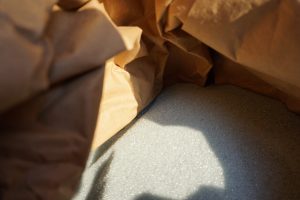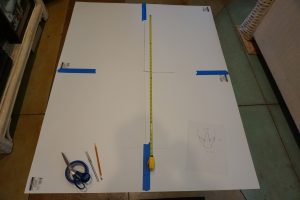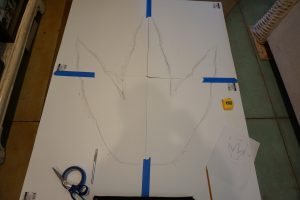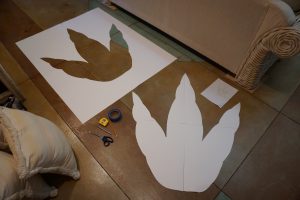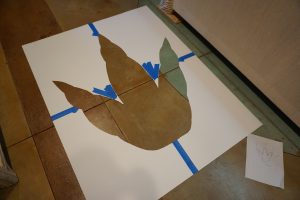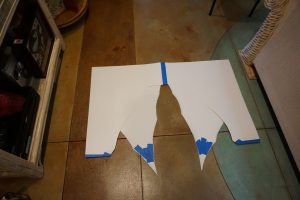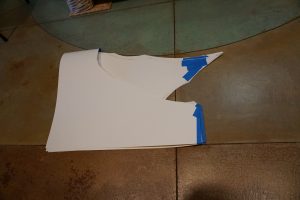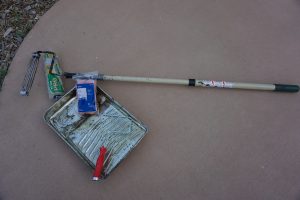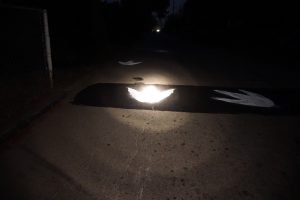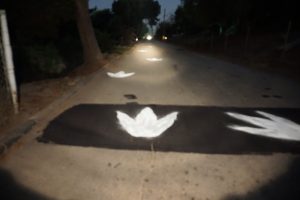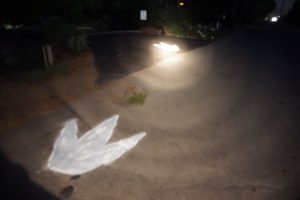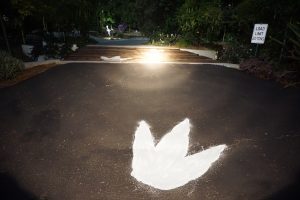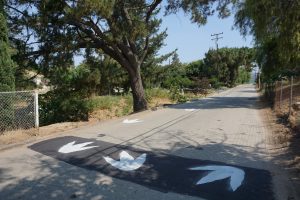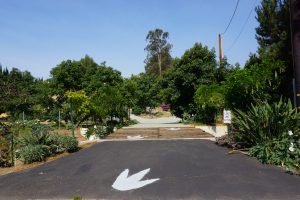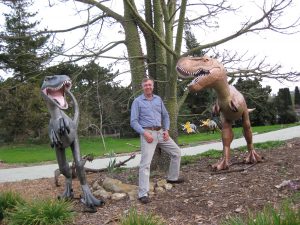Saturday was a big day at the Park. It was the first event held here. Look for more on next weekend’s post “Picnic with Dinosaurs”. There was a great deal to do in preparation for the visitors. One activity was to repaint the speed bump to make it very visible for drivers. Initially I thought I would obtain some traffic paint black for the bump and white for fresh stripes. But wait this is the road in front of PaulsPrehistoricPark.com, surely we can be more creative. Yes, Dinosaur Tracks is what we need here.
Note: The road in front of PaulsPrehistoricPark.com is private and the property lines reach the center of the street. You need to check with your local authorities to obtain approvals before attempting this in your neighborhood. However, you may have a pathway or patio where you can try this activity at home. Again, check for any required approvals first.
The first step was to locate materials for painting asphalt. I found www.asphaltsealcoatingdirect.com with my Goggle search. They make traffic paints and they also sell glass beads. You can sprinkle the glass beads on the wet paint and they will provide a reflective surface – day and night. They have fast drying paints (10 minutes), which is especially helpful.
With the paint on order it was time to design the Footprints. This is where my visits to the Natural History Museum Los Angeles and the Local Public Library pay off. I wanted the prints to be as realistic as possible. In my case they would be fresh verses 65 million years or older. After looking through all the Dinosaur Books in the City of Camarillo Library, I found one that might meet my needs. In addition, Joshua the Reference Librarian found a couple of books at other Libraries that he arranged to borrow under the library loaner program. They were helpful. But it turned out the book I checked out from Camarillo’s collection met my needs best – “A Field Guide to Dinosaurs – The Essential Handbook for Travelers in the Mesozoic”. By Henry Gee and Luis V. Rey was published in 2003. It contains a number of sketches that will be useful to me for other projects. Most useful for this project are the drawings of footprints. I extended my check out to allow for a cover to cover reading and a proper book review. I must admit it was the pictures I needed for now.
I started with a small drawing for a T-Rex footprint. Then based on the math discussed below I scaled the drawing up to a 3.5 foot long full size drawing. I used poster board that I found at Staples to make the template. I needed 4 sheets of 22 inch by 28 inch poster board to have room for a 3.5 foot footprint. I didn’t need the x-acto knife – the scissors worked fine. After the cutting was complete I used blue tape to reinforce weak spots. Making the template from 4 boards made it possible to fold-up for easier storing until needed
If you remember my book review of “Dinosaurs Without Bones: Dinosaur Lives Revealed by Their Trace Fossils” by Anthony J. Martin published 2014 you will recall Anthony provided the math calculations for footprint size and spacing based on walking, trotting or running. You never know when algebra will come in handy! The review was in my March 25, 2017 post – A “Dinotopia” Reading & Dinosaurs in the Public Library – Book Review continued.
H = 4L, S = H x (motion factor),
H is the Hip Height of the Dinosaur, L is the Length of the footprint, S = the Stride
The motion factors are < 2 walking, 2 – 2.9 trotting, > 2.9 running
Therefore, a T-Rex with a 14 foot hip height would produce a 3.5 foot long footprint every 28 – 40.6 feet while trotting. Anyone want to check my math? If you would like more details on how the motion factor was determined, check out Anthony’s book.
I picked up roller brushes for rough surfaces and I have an extendable roller handle. This makes it easier covering large areas on the ground. I preferred the mini brushes to paint over the template. They gave me more control getting paint into the detailed parts. It’s very important the area is clean prior to painting or your rollers will pick up a great deal of dirt and waste paint. I had previously broom cleaned the short asphalt strip in front of my bridge. However, it wasn’t clean enough when I applied the black paint. It took much longer to finish that area, as a result. I should have hosed or air pressure cleaned that section. The speed bump and the sections where the Footprints were to be painted, I broom cleaned, hosed and broom cleaned again prior to painting. That seemed to do the trick.
I was able to block half the road for a short period of time. I didn’t start work until after 7:30 PM to reduce the impact to my neighbors. Immediately after using the white paint on the template, I used a plastic measuring cup to sprinkle the glass beads. I wore a mask when I did this as a precaution. The beads are very fine like sand and I wanted to make sure I didn’t accidently inhale any. Two neighbors stopped as I was cleaning up advising me how their sons & daughters love the dinosaurs in the park and were very excited to see the foot prints. By the time I cleaned everything up it was after dark.
It’s time to track a T-rex. As you follow the tracks across the bridge they suddenly disappear and only a Raptor can be seen. Where did that T-Rex go?
The weight limit on the bridge is 20 tons. Good thing the Adult T-Rex only weighs 6 or 7 tons. The next morning the T-Rex prints sparkle in the sunlight. The Magic of Dinosaurs!
Join us next weekend to see Classic Cars amongst the Dinosaurs. Some feel Old Cars are Metal Dinosaurs. If that’s the case they’ll fit right in at PaulsPrehistoricPark.com.
“Dedicated to Saving Metal Dinosaurs”
Paul & Prehistoric Pals
Your feedback is appreciated, Thank you!
